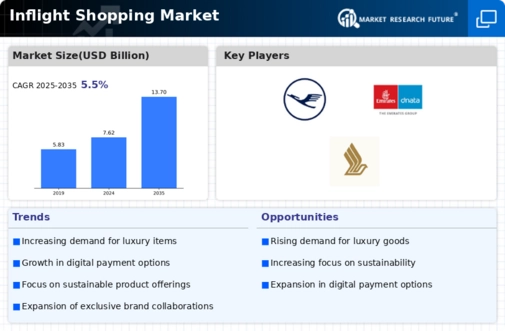Market Share
Inflight Shopping Market Share Analysis
The inflight shopping market, an integral part of the aviation industry, has evolved as airlines seek to enhance the passenger experience and tap into additional revenue streams. Within this unique retail environment, companies engaged in inflight shopping are employing diverse market share positioning strategies to capture the attention and spending power of passengers.
One predominant strategy is product assortment and exclusivity. Inflight retailers carefully curate their product offerings to cater to the diverse preferences of passengers. This involves selecting a mix of duty-free items, luxury goods, and unique merchandise not readily available on the ground. By offering exclusive or limited-edition products, inflight retailers aim to create a sense of urgency and novelty, encouraging passengers to make impulse purchases. This strategy relies on the appeal of inflight exclusivity, positioning the airline's retail offerings as distinct from traditional shopping experiences.
Pricing strategies play a crucial role in the inflight shopping market. Airlines often leverage the duty-free advantage, providing passengers with products at prices lower than those found in traditional retail outlets. Additionally, promotional pricing, bundle deals, and time-limited discounts are commonly employed to stimulate sales during the relatively short duration of a flight. By strategically pricing products to appeal to passengers' perception of value and savings, inflight retailers position themselves as providers of cost-effective shopping opportunities, contributing to increased market share.
Partnerships and collaborations are key components of market positioning in the inflight shopping sector. Airlines frequently collaborate with renowned brands, designers, and duty-free operators to enhance their retail offerings. These partnerships bring credibility, brand recognition, and high-quality products to the inflight shopping experience. By aligning with reputable partners, airlines aim to attract passengers seeking trusted and premium brands, reinforcing their position as providers of a sophisticated and desirable shopping environment.
Personalization is an emerging trend in inflight shopping market share positioning. Airlines are leveraging data analytics and passenger profiles to tailor their retail offerings to individual preferences. By understanding the demographics, travel history, and purchasing behavior of passengers, inflight retailers can customize their product recommendations, promotions, and marketing efforts. This personalization strategy aims to create a more engaging and relevant shopping experience, increasing the likelihood of passenger participation and loyalty.
Digital technology and inflight entertainment systems are also instrumental in market share positioning within the inflight shopping sector. Airlines are investing in user-friendly digital platforms that allow passengers to browse, select, and purchase products seamlessly during their flight. Interactive touchscreens, mobile apps, and pre-ordering options enhance the convenience and accessibility of inflight shopping. Companies that prioritize a smooth and enjoyable digital shopping experience position themselves as innovative and customer-centric, gaining a competitive edge in the evolving landscape of inflight retail.
Brand building and marketing efforts are essential for inflight shopping market share positioning. Airlines promote their inflight shopping services through various channels, including in-flight magazines, digital platforms, and pre-flight communications. Highlighting the unique offerings, exclusive deals, and the overall shopping experience contributes to shaping a positive perception among passengers. Successful marketing campaigns create awareness, generate anticipation, and drive passenger interest in inflight shopping, ultimately influencing purchasing behavior.






Leave a Comment